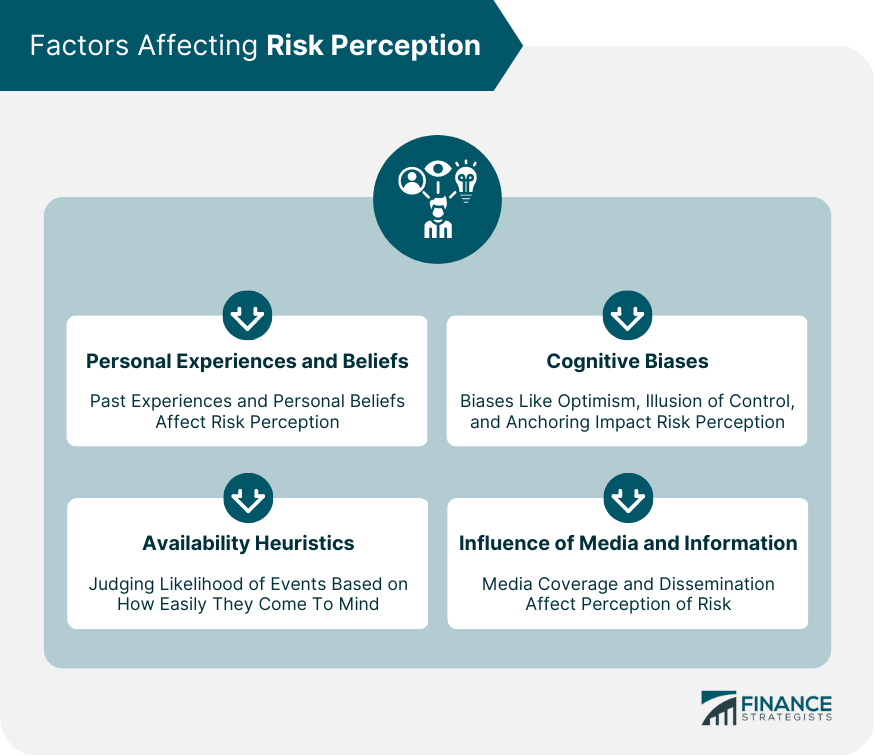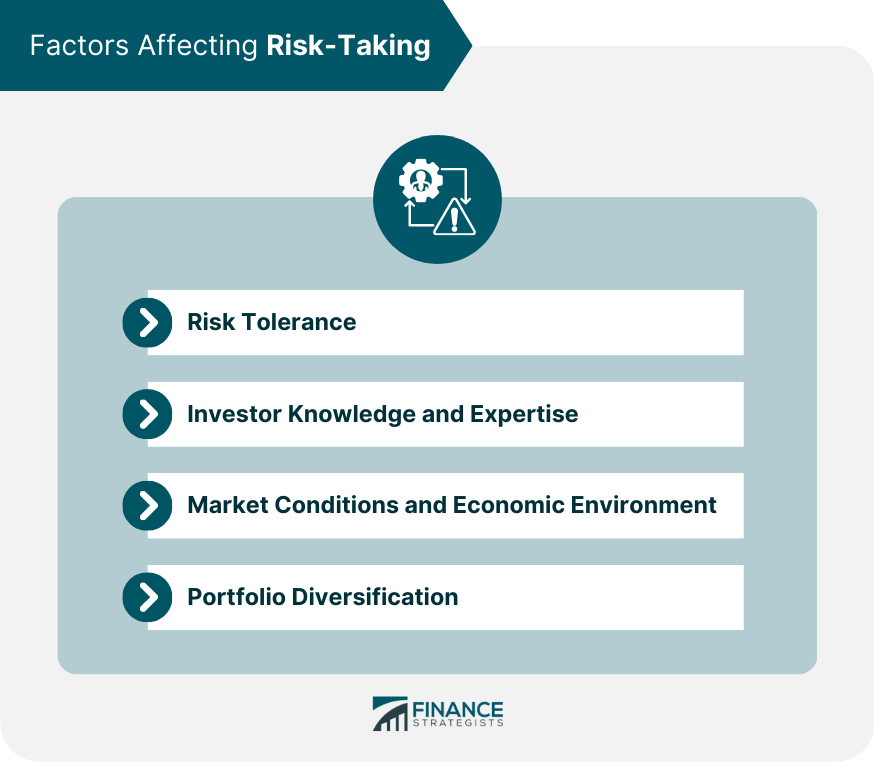Risk perception refers to an individual's subjective assessment of the likelihood and potential consequences of a particular risk. In the context of wealth management, risk perception shapes an investor's attitude toward various investment options and informs their decisions. On the other hand, risk-taking is the act of engaging in activities or making decisions with uncertain outcomes, potentially resulting in gains or losses. In wealth management, risk-taking refers to an investor's willingness to accept potential losses in pursuit of higher returns. Understanding the interplay between risk perception and risk-taking is crucial for wealth management, as it can significantly impact investment decisions, portfolio performance, and the achievement of financial goals. An individual's personal experiences and beliefs can significantly shape their perception of risk. Past experiences with investments and financial outcomes can influence how an investor assesses future risks. Availability heuristics refer to the tendency of individuals to base their judgments on information that is readily available or easily recalled. This can lead to an overestimation or underestimation of risk, as investors may not consider all relevant information or historical data. Overconfidence bias occurs when investors overestimate their ability to predict outcomes or believe they possess superior knowledge or skills. This bias can lead to an underestimation of risk and overly aggressive investment strategies. Loss aversion is the tendency to prioritize avoiding losses over pursuing gains. Investors exhibiting loss aversion may be overly risk-averse, potentially missing out on opportunities for higher returns. The media and available information can significantly impact risk perception. Sensationalized news stories or dramatic market events can lead to skewed perceptions of risk, causing investors to make emotionally driven decisions. An investor's age and life stage can significantly influence their risk tolerance. Younger investors may have a higher risk tolerance, as they have a longer time horizon to recover from potential losses, while older investors may prioritize preserving wealth and minimizing risk. An investor's financial goals and time horizon also impact risk-taking. Long-term financial goals may warrant a higher level of risk-taking to achieve desired returns, while short-term goals may require a more conservative approach. Investors with greater knowledge and expertise in financial markets may be more willing to take risks, as they may have a better understanding of potential outcomes and the ability to make informed decisions. Prevailing market conditions and the economic environment can influence risk-taking behaviors. In periods of market uncertainty or economic downturns, investors may be more risk-averse, while periods of market growth and stability may encourage greater risk-taking. A well-diversified portfolio can mitigate risk, encouraging investors to take on more risk in pursuit of higher returns. Diversification across asset classes, sectors, and geographic regions can help reduce the potential impact of market fluctuations and negative events on portfolio performance. Risk perception plays a critical role in investment decisions, as it determines how investors view potential risks and rewards associated with various investment options. Misaligned risk perceptions can lead to suboptimal investment decisions and portfolio performance. To achieve financial goals, investors must strike a balance between risk perception and risk-taking, ensuring that their investment decisions align with their risk tolerance, time horizon, and financial objectives. Finding this balance can help investors avoid overly conservative or aggressive strategies, which may hinder the achievement of their goals. Financial advisors can play a crucial role in shaping investors' risk perception and guiding them toward appropriate risk-taking behaviors. Advisors can help investors identify and address cognitive biases, provide education and resources, and develop personalized investment strategies that align with their clients' risk tolerance and goals. Improving investor education and financial literacy can help individuals better understand and assess risk, leading to more informed investment decisions and appropriate risk-taking behaviors. By recognizing and addressing cognitive biases, investors can make more rational and objective decisions, helping to align risk perception with actual risk levels. Behavioral finance techniques, such as framing, mental accounting, and goal-based investing, can help investors overcome cognitive biases and improve their risk perception and risk-taking behaviors. Technology and data analysis tools can help investors better understand risk and make more informed decisions. Tools such as risk analytics software, portfolio optimizers, and robo-advisors can provide valuable insights and guidance for investors navigating risk perception and risk-taking. Creating a comprehensive financial plan can help investors align their risk perception and risk-taking behaviors with their financial goals. A well-crafted plan considers an investor's risk tolerance, time horizon, and objectives to create a roadmap for investment decisions. Investors should regularly review and adjust their investment strategies to ensure that their risk perception and risk-taking behaviors continue to align with their financial goals, especially as market conditions change and personal circumstances evolve. Investors must balance short-term and long-term risks and rewards when making investment decisions. This requires an understanding of the trade-offs between risk and return and the ability to maintain a long-term perspective while navigating short-term market fluctuations. Understanding the relationship between risk perception and risk-taking is essential for effective wealth management. By addressing cognitive biases, enhancing financial literacy, and implementing behavioral finance techniques, investors can better align their risk perceptions with actual risks and make more informed decisions. Investors and financial advisors can employ a variety of strategies to improve risk perception and encourage appropriate risk-taking, such as utilizing technology and data analysis tools, developing comprehensive financial plans, and regularly reviewing and adjusting investment strategies. Financial advisors play a critical role in helping investors navigate the complex interplay between risk perception and risk-taking. By providing education, resources, and personalized guidance, advisors can help their clients make informed decisions that align with their risk tolerance and financial goals.Risk Perception vs Risk-Taking: Overview
Factors Affecting Risk Perception
Personal Experiences and Beliefs
Availability Heuristics
Cognitive Biases
Overconfidence Bias
Loss Aversion
Influence of Media and Information

Factors Affecting Risk-Taking
Risk Tolerance
Age and Life Stage
Financial Goals and Time Horizon
Investor Knowledge and Expertise
Market Conditions and Economic Environment
Portfolio Diversification

The Relationship Between Risk Perception and Risk-Taking
Impact of Risk Perception on Investment Decisions
Balancing Risk Perception and Risk-Taking in Wealth Management
The Role of Financial Advisors in Shaping Risk Perception and Encouraging Appropriate Risk-Taking
Strategies to Improve Risk Perception and Risk-Taking
Enhancing Investor Education and Financial Literacy
Identifying and Addressing Cognitive Biases
Implementing Behavioral Finance Techniques
Utilizing Technology and Data Analysis Tools
The Importance of Aligning Risk Perception and Risk-Taking With Financial Goals
Developing a Comprehensive Financial Plan
Regularly Reviewing and Adjusting Investment Strategies
Balancing Short-Term and Long-Term Risks and Rewards
Conclusion
Risk Perception vs Risk-Taking FAQs
Risk perception refers to an individual's subjective evaluation of the likelihood and severity of potential harm from a particular situation or activity. On the other hand, risk-taking refers to an individual's willingness to engage in a situation or activity despite the potential risks. While risk perception is based on one's perception of the danger, risk-taking is based on the individual's willingness to accept the risk.
Risk perception can significantly impact risk-taking behavior. If an individual perceives a particular activity or situation as being high risk, they are less likely to engage in it. However, if the person perceives the risks to be low, they are more likely to engage in it. Furthermore, if an individual's risk perception is high, they may take more precautions and engage in safer behaviors, while if their risk perception is low, they may be more likely to engage in risky behaviors.
Yes, research has shown that risk perception and risk-taking are related to personality traits. Individuals with high levels of extraversion, openness to experience, and sensation-seeking tendencies are more likely to engage in risky behavior. Additionally, individuals with high levels of neuroticism tend to have higher risk perception and avoid risky behavior.
Yes, interventions aimed at changing risk perception can modify risk-taking behavior. For example, providing individuals with accurate information about the risks associated with a particular activity can increase their risk perception, which may lead to reduced risk-taking behavior. Similarly, providing individuals with positive role models who engage in safe behavior can also lead to increased risk perception and reduced risk-taking behavior.
No, risk perception and risk-taking behavior vary from person to person. Different factors such as age, gender, culture, and previous experiences can influence an individual's risk perception and risk-taking behavior. Furthermore, individuals may perceive and take risks differently depending on the situation or activity in question.
True Tamplin is a published author, public speaker, CEO of UpDigital, and founder of Finance Strategists.
True is a Certified Educator in Personal Finance (CEPF®), author of The Handy Financial Ratios Guide, a member of the Society for Advancing Business Editing and Writing, contributes to his financial education site, Finance Strategists, and has spoken to various financial communities such as the CFA Institute, as well as university students like his Alma mater, Biola University, where he received a bachelor of science in business and data analytics.
To learn more about True, visit his personal website or view his author profiles on Amazon, Nasdaq and Forbes.















